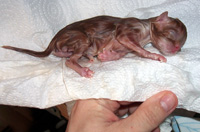
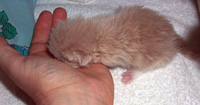
| Return
to Index Page |
Home Page |
|
|
|
|
Hand Feeding or Supplemental Feeding
When a Queen experiences distress trying to feed kittens, she may reject them and refuse to nurse them. This usually occurs after a C-Section but sometimes happens with new mothers who get frightened when the kittens suckle and the sucking is either uncomfortable or hurts. Another difficult situation is if the Queen dies during or anytime afterward and before the kittens are weaned.
The first 24 hours are vital to the kittens. The milk the Queen produces includes anti-bodies that provide a passive protection for the kittens for about 6 weeks until their immune system can begin to provide its own protection. Early vaccinations at about 2 weeks when their eyes open can provide additional protection when appropriate. The breeder must try to get some of the Queen's milk to the kittens within the first 24 hours even if suctioning milk is required. After the 24 hour window (approximate), the kitten's systems no longer accept the passive protection and even if the anti-bodies continue to be delivered, they are no longer effective. So, again, the first 24 hours are critical.
Kittens that receive the Queen's milk and are supplemental fed, have
not experienced vaccination distress in our Cattery. Kittens that
have not had the Queen's milk at all or had very little milk from the
Queen
before being hand fed, tend to react to the first vaccination and
develop
clinical symptoms such as sneezing, eye watering and runny noses.
The symptoms do not last long but can affect their appetite which can
cause
weight loss, blood/sugar imbalances and dehydration. Remember,
these
kittens are really small weighing from 1.5 ounces to 6 ounces at birth,
loosing weight in the first 24 hours and then gaining weight after and
growing rapidly for several weeks. The more the Queen provides
the
kittens, the larger they get. The first 8 weeks are critical and
the first 16 weeks determine the long-term health of the kitten.
Therefore, you will find most breeders keep kittens for 16 weeks before
allowing them to leave the Cattery. In addition, a kitten can get
its Rabies shot and booster vaccination at 16 weeks so if the new owner
is a pet owner, then there will be no need to re-vaccinate for a year.
| As you can see, a kitten just born is very small and besides being wet, looks extremely small because it has not been feeding or breathing outside of the Queens womb. |  |
| After 10 days, the same kitten is plump, dry and much larger in spite of being hand fed after its mother died about 36 hours after giving birth. Kittens do not usually do well without a mother but this one has decided that it knows the "hand that feeds" him. |  |
Supplemental feeding is a judgment call. If the Queen is
either
experiencing pain feeding the kittens or the kittens are always hungry,
it is a good idea to consider supplemental hand feeding. The
kittens
have usually grown large enough to be handled such that they can be fed
by allowing them to suckle from a nipple. Kittens, however, are
very
small and the large nippled plastic bottles will be too large for most
of them. Look at the Queen. If her teats are small, use
them
as an example of what size nipple is needed. Camelot Cats has
found
that the rubber nipples taken from the "Catac Products, Limited,
Standard
Feeder" has the smallest nipples (ST1) which are most like a Persian
Queen
(our). However, this product also includes a glass bottle with a
large open end which makes controlling the flow of milk difficult and
does
not allow accurate metering of how much a kitten receives each
feeding.
Alternately, we put the small nipple from the "Catac Products, Limited,
Standard Feeder" and install it on the end of a 1, 2, 5 and then 10 cc
syringe. Syringe feeding provides both precision flow control and
quantity. The worst thing you can do is cause the kitten to
inhale
the milk into its lungs. Once a kitten aspirates milk, the
chances
of its survival is slim to none. Most kittens lost in the first
two
weeks are lost to milk aspiration. Sometimes you can't do
anything
to prevent it from happening, however, most of the time, it is late,
your
tired from feeding every two to four hours and you let down your guard
just for a moment. If a kitten does get milk in its nose or if
milk
comes out of its noes, take a small suction ball and suck the milk out
as quickly as possible. Aspiration usually occurs only after the
milk comes out of the nose and a quick response can save the kitten;
you
have only seconds. Always keep a suction ball close at hand when
feeding kittens.
| An example of hand feeding using a syringe shows how to hold the kitten and the syringe. Do not push the plunger. The kitten will suck it down naturally. If the plunger gets stuck, only rotate it or remove it from the kitten before trying to clear the restriction. DO NOT FORCE ANY MILK INTO THE KITTEN OR IT WILL ASPIRATE MILK INTO ITS LUNGS AND DIE. | 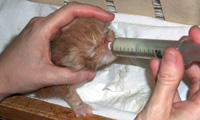 |
So far, all I have done is refer to what you feed the kittens as
"milk".
Well, not so simple. What you need is a kitten replacement
product available from your Veterinarian, pet store or from
most
catalog sales companies. There are several products on the market
that do a fine job. We use a product called "Just Born" for the
kittens
when they are less than 3 weeks old. We then use another product
as the kittens get older. In addition, we have several alternate
products, including goat's milk, when kittens refuse one or the other
or
appear to react badly to one.
The most difficult job is keeping kittens alive when the mother dies. Very small kittens may need to be tube-fed, take very little milk at each feeding and must be fed every 1-2 hours (in the beginning). If your lucky, all the kittens managed to nurse from the Queen for a day or two and will suck milk from a nipple. The three critical factors are temperature, blood/sugar and hydration. Allow any of the three to get out of balance and the kitten will die.
Very small kittens also need to be kept warm. The Queen keeps the kittens next to her and each other to help regulate their body temperature. It takes about a week before kittens can regulate body temperature well enough to keep warm. If there is no Queen to keep the kittens warm, one method that works is a heating pad under a water bottle (moist heat). If the temperature is too high, the kittens will overheat and dehydrate and die. If the temperature is too low, the kittens will get cold an hypothermic and die. A careful control of the temperature will keep the kittens comfortably warm. The breeder must always be alert and check on the kittens regularly in case one strays from the group and gets cold or the heating pad gets too hot. The best test for temperature is to hold the kitten regularly. If the kitten feels warm, that's normal if the kitten feels cold, that's bad. Hot must be avoided, period!
Dehydration can be tested by lifting the loose skin on the back of the kitten. It should return to normal quickly and not stick up where you lifted it. Fluids and normal body temperature prevent dehydration (unless the kitten is dysentery). Normal feeding and a temperature controlled environment is about all you can do but all you must do.
Blood sugar is the hardest to recognize and is a guess at best. If the kitten is lethargic or limp, then a drop of Karo Syrup (clear) on the tongue is about all you can do and, again, all you must do. Use a tooth pick to get a small drop or break off the end of a Q-Tip and dip in the end without the cotton. Don't ever over-do anything. Karo Syrup twice a day is plenty and stop as soon as the kitten begins to show movement and strength.
Additionally, kittens that have no mother must have a surrogate mother. If you don't have another Queen that can either take care of them and/or feed them, you must take on the job yourself. Surrogate has a lot of additional duties, however, one thing I absolutely refuse to do is lick their buts! You must be resourceful and develop techniques that are acceptable substitutes for cleaning and helping them with their other required bodily functions.
Remember that when the Queen licks the kittens, she cleans them,
grooms
them and massages them as well. The Queen is truly multi-tasking
all the time, especially with more than one kitten. The following
sequence is typical of what you can expect to do three to four times a
day. Kittens take in milk pretty easy but when it come time to
clean
them selves or experience regular bodily functions, they usually get a
lot of help from their mother and her tongue.
| Kittens take in milk naturally. The breeder must be careful not to over feed or force-feed the kitten. Milk aspiration can occur quite easily and if the kitten gets milk in its lungs, it will die. | 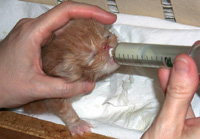 |
| After feeding a nice warm wet rag strategically placed helps the kitten urinate. If you don't potty the kitten, you will be cleaning up the cage a lot more often and the kittens will require more baths than if you take the time to do what mama does. Most important is the bonding and imprinting that occurs when you take good care of the little things. Just look at that belly! | 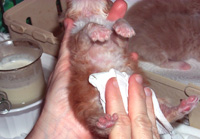 |
| Every other feeding, you can use warm water on the tummy to get them to relax so that they can experience a bowel movement. This event is far more difficult for the kitten to manage on its own. They almost always scream loudly, even after they begin to use the litter box. | 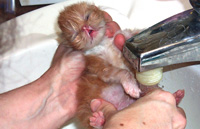 |
| During the first few weeks, feces changes color and solidity. Unless they pass this waste, they experience real pain and can even get sick and die. Mother licks them, rubbing their tummy and then cleans up after. I prefer to run water on the tummy and let the sink take the hit. Bottom line is either this stuff goes down the sink or it ends up in their bed and you get to clean it up either way. | 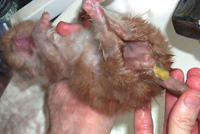 |
| Once fed and otherwise taken care of, kittens do the last thing they do best, sleep. This is when they look and act their best. Sleeping in a pile helps keep their body temperature regulated and they continue to do this with exceptions. |  |
| Finally, even after you diligently clean and potty them, they still leave a mess behind. So, plan alternate beds so you can transfer them to the alternate while you clean the one. We use paper towels on top of cloth. The paper towels take the mess and can be thrown away and the cloth provides insulation and a soft bed. Not all will be soft and cuddly. | 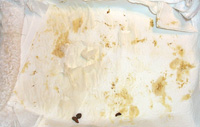 |
Tube feeding is not for the amateur. To tube feed a kitten,
you
first must be sure it won't feed on it's own and really be sure.
Second, you must have a tube small enought for a kitten. Third,
you
must measure the distance to the stomach and to the lungs; marking the
feeding tube for the distance to the stomach. The hard part is
getting
the tube into the kitten if it is active. Kittens won't want a
tube
forced down it's throat any more than you would. When they want
to
protest the four paws become four hundred and they have a strength you
won't believe. Use KY Jelly on the tube and make sure the tube is
designed for tube feeding (soft and no sharp edges). The tube is
connected to a syringe filled with the correct volume of milk for the
kitten.
This varies over time and with different size kittens. Once you
are
sure the tube is in the stomach and not in the lungs, you squeeze the
milk
slowly into the stomach. The tube and syringe must both be full
of
milk and free of air or all you will do is put air in the stomach and
if
you continue with milk, you will rupture something. You can kill
a kitten faster trying to tube feed than any way I know. When
in doubt, go to your kitty Veterinarian!
| Return
to Index Page |
|
Home Page |